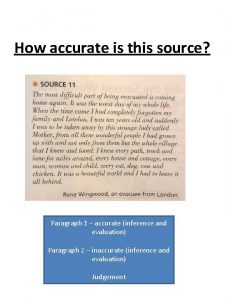Vasari Talk How accurate is Vasari Wednesday 11










- Slides: 10

Vasari Talk – How accurate is Vasari? Wednesday 11 th October 2012 © 2011 Autodesk

Outline of discussion topics… § Energy analysis (20 -25 min): § § § Solar analysis (5 -10 min): § § The purpose of Vasari / Conceptual Energy Analysis Main drivers of energy use/cost (and analysis) of buildings Computational accuracy Vs. Information accuracy DOE 2 simulation engine strengths and weaknesses Key things to watch out for Outline of the computational method Wind analysis (5 -10 min): Computational Fluid Dynamics § 2 D & 3 D / Meshing / Turbulence § Validation § § Q&A (15 -30 min) © 2011 Autodesk

Energy analysis… The purpose of Vasari / Conceptual Energy Analysis: § § § BIM based (parametric) conceptual modeling Application to early design stage e. g. master planning, concept Rapid model development and feedback on performance Building form and envelope ‘optimization’ ‘Directionally accurate’ analysis © 2011 Autodesk

Energy analysis. . . Main drivers of energy use / cost (and analysis) of buildings: Driver Climate Form / Layout Materials Systems Design / Operational Components Operational • • Air temperature Relative humidity Direct & Diffuse solar radiation Wind speed & direction • • • Typical Meteorological Years (TMYs) 1. 2 million+ worldwide (2004 & 2006) Exact location and period specific (GBS) Design • • Orientation Massing Percentage glazing Exterior shading • Conceptual masses with auto-zoning • • • Layer Density, Specific Heat Capacity and Conductivity Element Absorptance, Roughness Glazing U-value, SHGC, VLT • • Lighting, Equipment Primary heating and cooling Secondary distribution Controls Occupancy Hours of operation Set-points $ / k. Wh electricity $ / k. Wh fuel Design Use Operational • • • Tariffs Operational • • © 2011 Autodesk Vasari Information / Assumptions Reliable / Consistent Goal of Vasari / CEA • Conceptual constructions (broad brush typical, high or low performance options) • • ASHRAE building / space type data (fixed) ASHRAE baseline system types (‘generally’ / fixed) Set by building / space type • ASHRAE building / space type data (fixed) • State wide flat rate averages Reasonable assumptions

Energy Analysis… Computational accuracy Vs. Information accuracy: Main Information Components: Main Computational Components: Driver • • Air temperature Relative humidity Direct & Diffuse solar radiation Wind speed & direction • • Orientation Massing Percentage glazing Exterior shading • • • Layer Density, Specific Heat Capacity and Conductivity Element Absorptance, Roughness Glazing U-value, SHGC, VLT Systems • • Lighting, Equipment Primary heating and cooling Secondary distribution Controls Use • • • Occupancy Hours of operation Set-points Tariffs • • $ / k. Wh electricity $ / k. Wh fuel nd pr e ov rst en oo … d lu el W © 2011 Autodesk tim Info e rm ar a e tio by n fa , un rt d he er w sta ea nd ke in st g lin an ks d … an d Climate External and internal heat losses and gains via conduction, convection & radiation + HVAC system efficiency Components Form / Layout Materials

Energy analysis… § DOE 2 simulation engine strengths and weaknesses: Whole building dynamic thermal energy simulation + Well understood and proven + Very fast + - Hourly time steps Decoupled building and HVAC system simulation Some simplification of building thermal mass Some simplification of solar radiation transfer Limited inter-zonal air exchange (‘bulk’ airflow simulation) Advanced HVAC systems e. g. displacement ventilation, radiant heating/cooling etc. © 2011 Autodesk

Energy analysis… § Key things to watch out for: § § § § Large open spaces ‘Thermally complex’ like atria, double skin facades Highly glazed areas Advanced materials e. g. transparent insulation Advanced systems e. g. displacement ventilation, radiant h/c Passive solar features e. g. natural ventilation Building type detail e. g. an office vs a house Thermal bridging © 2011 Autodesk

Solar analysis… § Outline of the computational method Conceptual masses / surfaces § Latitude, Longitude and Site Elevation § Solar Azimuth & Altitude § Direct and Diffuse solar radiation: § Hourly values from climate data (can be downloaded from GBS) § Different climate data yields different results § § Validation © 2011 Autodesk

Wind analysis Computational Fluid Dynamics § Derived from Autodesk Moldflow (aka Falcon) and includes: § § § Automatic voxel based meshing 2 D & 3 D Navier Stokes Incompressible fluid / Finite volume Large Eddy Simulation (LES) Smagorinksy Turbulence model Transient i. e. simulates change over time Climate data driven to help understand local wind effects § Validation § © 2011 Autodesk Very fast!

Q&A… © 2011 Autodesk
 Amateurs discuss tactics professionals discuss logistics
Amateurs discuss tactics professionals discuss logistics Problem talk vs solution talk
Problem talk vs solution talk Talk, read, talk, write resources
Talk, read, talk, write resources Giorgia vasari
Giorgia vasari Barthes smrt autora
Barthes smrt autora Giorgio vasari sei poeti toscani
Giorgio vasari sei poeti toscani Wednesday journal prompts
Wednesday journal prompts How to write wednesday
How to write wednesday Wednesday two of the key
Wednesday two of the key Fe exam results wednesday
Fe exam results wednesday Enum week sunday monday
Enum week sunday monday


















